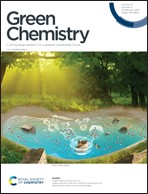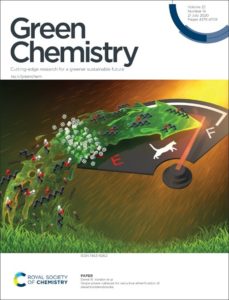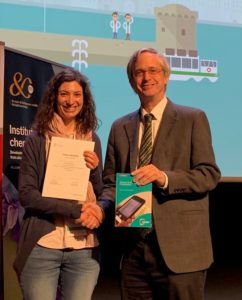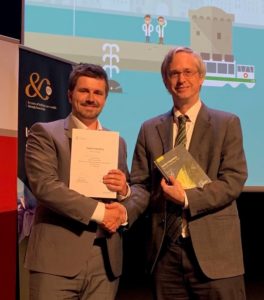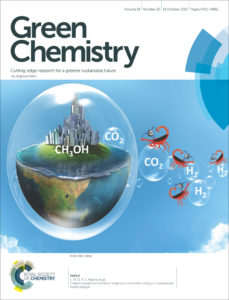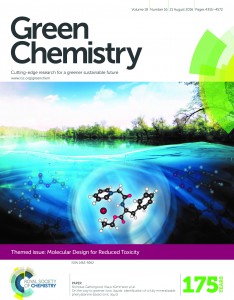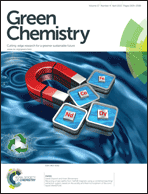We are delighted to announce that the Green Chemistry themed collection Biobased furanic derivatives for sustainable development is now online and free to access until the end of March 2022.
 This themed collection aims to gather the most advanced research in the area of furanic building blocks. These furanic platform molecules can be further derivatized and employed in various applications (thermoplastics; resins; biofuels; fine chemistry; green solvents, etc.). Their end-life (recycling, biodegradation), within a circular rational, is also a sparking field of research activity. Therefore, the biomass origin of these furanic molecules and the Green Chemistry principles that are employed to prepare, modify and dispose these molecules fit with the expectation of the journal.
This themed collection aims to gather the most advanced research in the area of furanic building blocks. These furanic platform molecules can be further derivatized and employed in various applications (thermoplastics; resins; biofuels; fine chemistry; green solvents, etc.). Their end-life (recycling, biodegradation), within a circular rational, is also a sparking field of research activity. Therefore, the biomass origin of these furanic molecules and the Green Chemistry principles that are employed to prepare, modify and dispose these molecules fit with the expectation of the journal.
Guest Edited by Drs Andreia F. Sousa, François Jérôme and Nathanaël Guigo, this collection reviews the very recent achievements of furanic derivatives in various areas of green and sustainable chemistry.
Read the full collection online
It includes:
Editorial
Biobased furanic derivatives for sustainable development
Nathanael Guigo, François Jérome and Andreia F. Sousa
Green Chem., 2021, 23, 9721-9722. https://doi.org/10.1039/D1GC90124A
Perspective
Furan platform chemicals beyond fuels and plastics
Roman Bielski and Grzegorz Grynkiewicz
Green Chem., 2021, 23, 7458-7487. https://doi.org/10.1039/D1GC02402G
Tutorial Review
Recommendations for replacing PET on packaging, fiber, and film materials with biobased counterparts
Andreia F. Sousa, Rafael Patrício, Zoi Terzopoulou, Dimitrios N. Bikiaris, Tobias Stern, Julia Wenger, Katja Loos, Nadia Lotti, Valentina Siracusa, Anna Szymczyk, Sandra Paszkiewicz, Konstantinos S. Triantafyllidis, Alexandra Zamboulis, Marija S. Nikolic, Pavle Spasojevic, Shanmugam Thiyagarajan, Daan S. van Es and Nathanael Guigo
Green Chem., 2021, 23, 8795-8820. https://doi.org/10.1039/D1GC02082J
Communication
Multicatalysis from renewable resources: a direct route to furan-based polyesters
Lucie Guillaume, Adam Marshall, Nicolas Niessen, Pingping Ni, Régis M. Gauvin and Christophe M. Thomas
Green Chem., 2021, 23, 6931-6935. https://doi.org/10.1039/D1GC01889B
Paper
Furfurylation protects timber from degradation by marine wood boring crustaceans
Lucy S. Martin, Stanislav Jelavić, Simon M. Cragg and Lisbeth G. Thygesen
Green Chem., 2021, 23, 8003-8015. https://doi.org/10.1039/D1GC01524A
Paper
A rigid plant oil-based thermoset with a furfural-derived cyclobutane cross-linker
Jonathan Tellers, Nicolas Sbirrazzuoli and Nathanael Guigo
Green Chem., 2021, 23, 8053-8060. https://doi.org/10.1039/D0GC04323K
Paper
Furoic acid and derivatives as atypical dienes in Diels–Alder reactions
Răzvan C. Cioc, Tom J. Smak, Marc Crockatt, Jan C. van der Waal and Pieter C. A. Bruijnincx
Green Chem., 2021, 23, 5503-5510. https://doi.org/10.1039/D1GC01535D
Paper
Heterogeneous photocatalyzed acceptorless dehydrogenation of 5-hydroxymethylfurfural upon visible-light illumination
Wanying Liang, Rui Zhu, Xinglong Li, Jin Deng and Yao Fu
Green Chem., 2021, 23, 6604-6613. https://doi.org/10.1039/D1GC01286J












